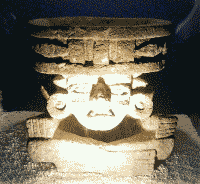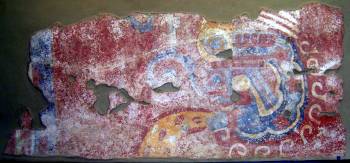Ancient Aztec Art

What was ancient Aztec art like? What influenced it? Art in the Aztec empire, like its culture and religion, came from a long history - a history of many different tribes. Techniques and themes in Aztec art were influenced by hundreds, perhaps thousands of years of artistry in this part of the world.
Few of the local languages actually had a word for "art". The Aztecs called special things like this toltecat. This word was from a group of people known as the Toltecs, whose city was destroyed in 1168. No doubt the massive statues of the gods in the abandoned city impressed the Aztecs. In fact, the ruling family of the Aztecs claimed to be descended from the Toltecs.
The common people were not generally allowed to even own works of art. If you were creating and selling art, you may be an exception, but some of the art would have to go to the upper classes. They were the ones that generally were the keepers of the precious objects in the empire.
Neither did the civilization keep all its art to itself. Ancient Aztec art was traded, and much of the materials used were imported from other peoples.
Themes in ancient Aztec art
The people of the empire had an appreciation for a wide variety of insects, birds, fish and animals. A lot of their art reflected this. Jaguars, ducks, monkeys, snakes, deer, dogs - all these were common themes. You can read more here about Aztec symbols.
Of course, a lot of the art that has been preserved was religion related. The gods were often depicted, and they themselves often resembled animals of various kinds. The drawings of the gods were often sharp and angular, brightly coloured. Art would often show gods, or priests dressed as gods in a ritual, or Aztec warriors in their finery.

Fresco of a snake, Aztec art from Teotihuacan
Common types of art
There was a rich variety of art in the empire. Richly coloured clothing, architecture, ceremonial knives, head dresses - many things were adorned with jewels and feathers. It is said that the emperor never wore the same clothes twice. His head piece that supposedly belonged to Emperor Montezuma II is a splash of bright green feathers, embroidered with gold and blue. Noble families had ear pieces, bracelets and necklaces.
Stories were commonly written in pictures, giving more opportunity for art. The pictographs may show the most recent conquest, or the sacrifices of the priests, or even daily life.
Statues made of stone, as well as Aztec masks, pottery, shields, knives, carved pillars and painted walls.
Art could be made with gold, silver, copper, jewels, feathers, coral, clay and stone, to name a few. As mentioned before, many of materials were not native to the region, but had to be bartered for.
Mosaics are very common in ancient Aztec art. Masks would be covered in turquoise, or shells (More on the making and purpose of Aztec masks...). Take for example the beautiful two-headed snake, probably worn as an ornament during ceremonial events, on display at the British Museum (see link below).
Characteristics
Ancient Aztec art was actually very lifelike. Many of their statues of people, as well as animals, look amazingly realistic. They also show age, and a great deal of expression. The art looks alive - but then again, much of it is about death itself. It again reflects the people's passion to avoid death and disaster, and then to conquer even that if it came.
For more...
For a few more glimpses of ancient Aztec art, check out:
- More surprising Aztec artifacts
- Interactive information about a past Aztec art exhibit in Los Angeles
- See more ancient Aztec art online at the University of Oregon (search for Aztec)
- The British Museum has a photo collection of Aztec art online. If you have the chance to visit it in person (as I have), do it! Meanwhile, check the "Research" section and search for "Aztec".
- Learn more about ancient Aztec pottery
- Investigate Aztec jewelry